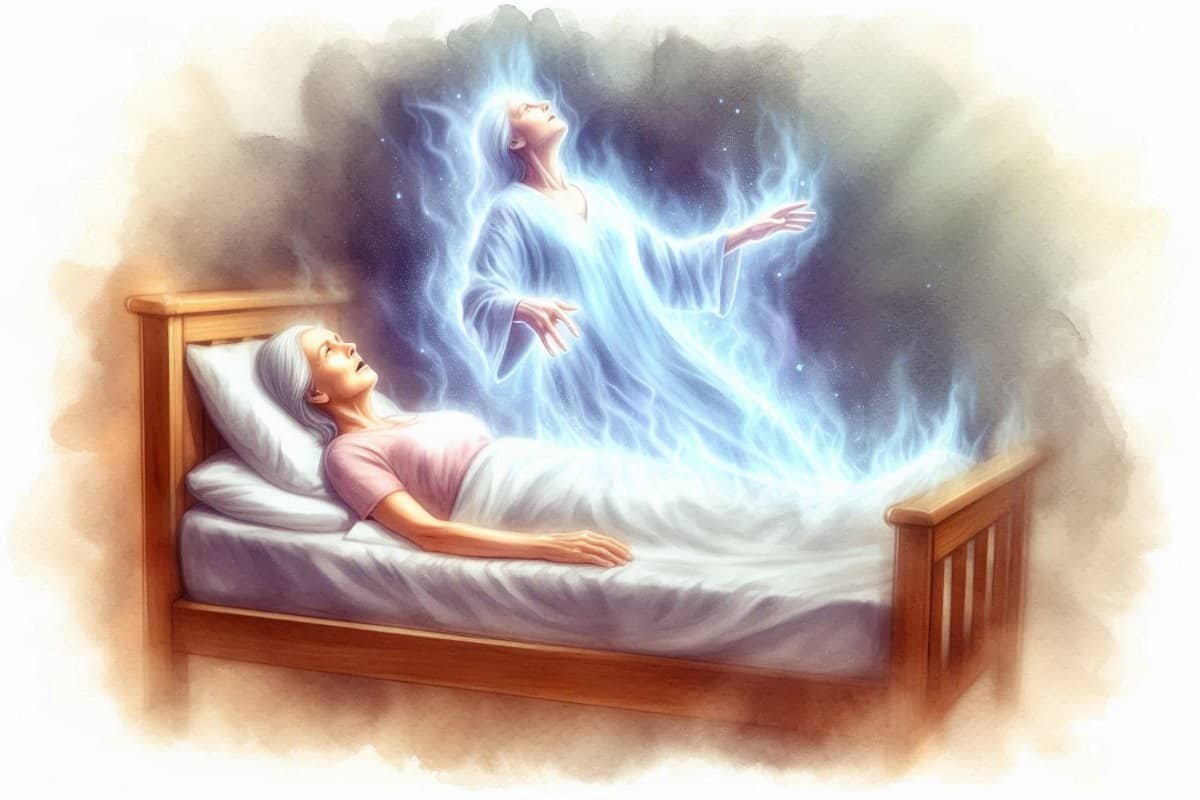The Weight of Mortality—Wrestling with Our Greatest Fear
We’ve all felt it—that quiet dread when the word “death” lands too close. Losing someone we love, or picturing our own end, it’s a shadow that creeps in, heavy and cold.
As the wrinkles set in, I’ve seen more funerals than parties, and it’s got me chewing on something big: what if there’s more to it? Not just the preacher’s promise or the skeptic’s shrug, but something thousands—across centuries—have glimpsed: Out-of-Body Experiences (OBEs) and Near-Death Experiences (NDEs).
Folks leaving their bodies, seeing beyond, and coming back with a message—maybe we don’t need to fear the end as much as we think.
Timeless Witnesses—Stories That Span Human History
Ever wonder what’s out there when the lights go dim?
OBEs and NDEs aren’t new—people have been talking about them since ink first hit parchment. Picture this: a farmer in 1600s England, flat on a haystack, heart stopped, suddenly floating above, watching his wife weep—then back, alive, telling the tale.
Or a soldier in the Great War, blasted out of his trench, drifting over the mud, seeing light, feeling peace—revived to whisper it later.
Fast forward to modern times—hospitals, operating rooms, carefully documented cases—thousands say the same thing: they left their physical bodies behind and found something waiting. Not just a neurological glitch—too many accounts, too similar, across too many cultures and time periods to dismiss lightly.
The Universal Journey—Patterns in Near-Death Accounts
What do they see?
The evidence stacks up like weathered stones marking a path. Dr. Raymond Moody’s groundbreaking 1975 book “Life After Life” cracked open this conversation.
He interviewed people who “died” and returned, charting consistent patterns. Bright lights, tunnels, loved ones waiting in the glow—it sounds like fiction, but these accounts come from everywhere.
The International Association for Near-Death Studies (IANDS.org) has logged thousands of experiences—from doctors, children, atheists, believers—recounting remarkably similar journeys: floating upward, looking down at their own bodies, feeling profound calm instead of fear.
A 5-year-old hit by a car sees her grandmother, dead for a decade, smiling—when back in her body, she’s oddly at peace. A surgeon, during his own heart attack, watches his operation from the ceiling—after revival, his relationship with death transforms completely.
These aren’t fairy tales—they’re raw, consistent testimonies from people across all walks of life.
Modern Witnesses—Finding Meaning in Contemporary Accounts
Dig into the vast library of NDE accounts online and you’ll find yourself swept away.
Eben Alexander, a neurosurgeon who should know better than most how the brain works, flatlined in 2008 from severe meningitis—yet he “went” somewhere: vivid realms, voices, a peace he couldn’t shake even after recovery.
His book “Proof of Heaven” reached millions—skeptics scoff, but his credentials and clarity are hard to dismiss.
Anita Moorjani’s powerful story in “Dying to Be Me” describes how cancer took her to the edge, she experienced herself outside her body, encountered her deceased father, and returned with an inexplicable healing that baffled her medical team.
These aren’t isolated cases—thousands of similar testimonies exist, from truck drivers to teachers, from children to the elderly. They can’t all be mistaken about what they experienced.
The Comfort of Continuity—Finding Peace in the Possibility
Why does this matter so deeply?
It’s not merely about proving heaven exists—though many describe exactly that, pearly gates or not. It’s about finding peace in our mortal journey—both for ourselves and those we love. If we’re more than just flesh and bone, then perhaps death is less an ending and more a transition.
We’ve all experienced that hollow ache after losing someone precious—where did they go?
These consistent stories whisper a comforting possibility: maybe they’re still whole, still themselves, just somewhere else. I once read about a woman from the 1700s who, in her diary, described seeing her brother after his death—happy, whole, at peace—which comforted her until her own passing.
Modern research supports this pattern—Dr. Bruce Greyson’s book “After” documents numerous cases of people encountering deceased loved ones during NDEs, feeling their presence, experiencing their continued existence.
One man who had lost his wife saw her during an OBE—and the calm that washed over him dissolved his fear of his own mortality.
We all carry that emptiness after loss—could these experiences be pointing toward something that might fill it?
Between Science and Mystery—Weighing the Evidence
Skeptics have their say—hallucinations, oxygen deprivation, brain chemistry gone haywire. It’s a fair counterpoint—science can’t capture photographic evidence of “the beyond.”
But here’s the fascinating part: why are these experiences so consistently similar? A 2021 University of Virginia study—led again by Dr. Greyson—found that NDErs’ recall was sharper and more coherent than dreams, not fuzzy like oxygen-deprived hallucinations.
Children too young to fabricate complex narratives, people with no measurable pulse for extended periods—they describe the same light, the same tranquility, some even say they encountered God.
Dr. Sam Parnia’s AWARE project has documented patients accurately describing objects and events from vantage points they physically couldn’t have seen—medical professionals can’t easily dismiss such findings.
While not definitive proof, these patterns suggest we might be designed for continuity beyond physical death.
Ancient Echoes—The Thread Through Human Experience
The weight of history adds substance to these modern accounts—Plato documented a soldier’s NDE in “The Republic” around 400 BCE, describing light, judgment, and return to life.
Even Jesus in the Bible spoke of existence beyond death, a consistent theme across time. Tibet’s “Bardo Thodol” (commonly known as “The Tibetan Book of the Dead”) maps the soul’s journey after physical death in ways that mirror contemporary accounts.
Medieval monks, indigenous shamans, ordinary people throughout history—all have described similar journeys: leaving the body, moving upward, discovering life continues.
Today’s testimonies—whether from an elderly grandmother tearfully recounting meeting her mother again or a veteran laughing about reuniting with his fallen squad members—echo these ancient narratives.
Hundreds of thousands of documented cases share this common thread. We’ve all heard whispers of something more—could this persistent echo across human experience be pointing toward truth?
Finding Courage—Seeing Death as a Doorway
So why fear what comes next?
If OBEs and NDEs hint at something true—and thousands of detailed accounts suggest they might—then perhaps death is not a wall but a doorway.
Losing someone will always bring grief—that’s the price of love—but what if they’re simply waiting in another room of existence?
That farmer, that child, that surgeon—they didn’t return trembling with terror; they came back with a profound sense of peace. Resources like “The Self Does Not Die” and countless firsthand accounts offer compelling evidence without preaching.
I’m no guru—just an aging soul contemplating what lies ahead. Now approaching my sixties, I’ve witnessed enough endings to wonder deeply: what if they’re not truly endings at all?
Quiet Moments—Finding Personal Peace
Death might not be the final chapter—which reminds me of John 14:2: “In my Father’s house are many rooms… I go to prepare a place for you.”
What steadies your fear when you face the shadow of mortality?
Your Turn—Let’s Talk About What Matters Most
Here’s my question to you—we all live with that shadow lurking somewhere in our awareness: death, loss, the great unknown. Have you ever explored OBEs or NDEs yourself? Has a particular story or account stayed with you?

Share your thoughts below—what’s the one idea or experience that brings you comfort when fear of the end creeps in? Let’s talk about it openly—no judgment, just honest conversation about the most universal human journey.



